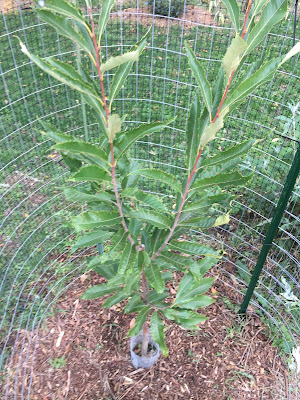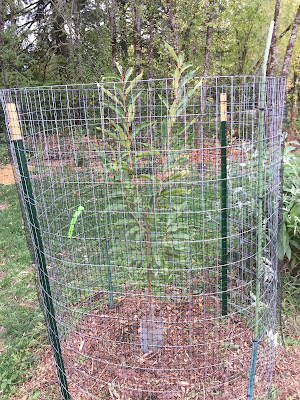 |
| Maraval Chestnut Tree in Deer Cage. 10.7.17 |
Things are winding down for the gardening season. I am starting some maintenance and improvement projects to help next year go better.
The make-shift
deer cages mostly worked for the young chestnut trees. Minimal damage. However, I wanted room to grow for next year, potentially the last year or next-to-last year they will need deer cages.
This year, some parts of my orchard had major, disappointing, set-backs due to failed deer cages and more aggressive browsing. I think there are more deer this year, and saw a group of five in a neighbor's yard this week. There are no deer predators now, and hunting is not allowed. I don't know what will happen as the population increases above what the ecosystem can handle. Meanwhile, with a hot dry summer, and probably more hunger and thirst, they ventured into tree and plant varieties that they would normally not eat, and they were more aggressive about getting into barriers that they would normally not bother with.
I usually use standard welded wire fencing, holes are 2 inches by 4 inches, and height 4 feet. That was usually fairly secure, but then deer learned to grasp leaves that stuck out through the fencing, pulling to rip off branches much further in the cage. In some cases, branches were pulled off the trees, leaving big wounds. One tree was completely destroyed. Deer also reached over some of the fences to chomp down branches that emerged above the cages. So, I changed some of the fences to plastic fencing with 1 inch gaps. That prevented leaves from sticking out through the gaps, but the material was too flexible, and in some cases the deer pushed the fencing down, giving access to entire trees to eat the tree. I want to be more prepared for next year, and avoid more disappointing damage if possible.
 |
| Maraval Chestnut Tree in Deer Cage. 10.7.17 |
Two of the new chestnut trees put on roughly 4 feet of growth this year, growing from about 2 feet tall to a little more than 6 feet tall. I cobbled together protective fencing as they grew, which mostly worked but didn't feel stable. I used the heavier metal fencing, and added either chicken-wire fencing, or plastic 1-inch mesh fencing, as a second layer of protection. Anticipating next year's growth, I wanted wider, taller fences, so built a new one yesterday for one of the trees.
Now it has stronger fence posts to prevent knocking the fencing over. The fencing is 6 feet tall, and is 2 layer, with both the sturdy, wide-mesh metal, and the narrower mesh plastic. As the tree grows next year, I may need to add a bit more, higher, level, but I think this will be good, for the most part, for protection in 2018. After that, I think these trees will be tall enough to dispense with the fences.
This was the chestnut variety Maraval. Next, I need to to the same for the Marissard seedling that grew as much, and the smaller Marigoule that I moved to a new location last week.
Edit 10/8/17: Now Marissard seedling is also in a new, larger, double-fencing cage too. I hope these work. It's really disappointing to check on trees and discovered that a year of effort, or more, has become a salad for roaming deer.
 |
| Marissard Chestnut Tree in Deer Cage. 10.8 17 |